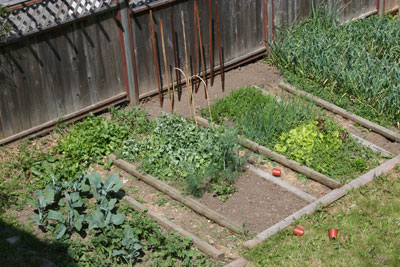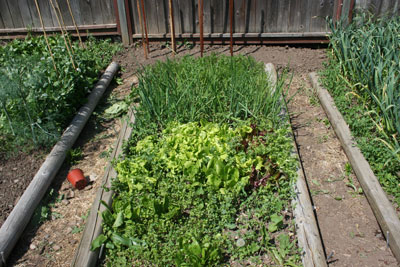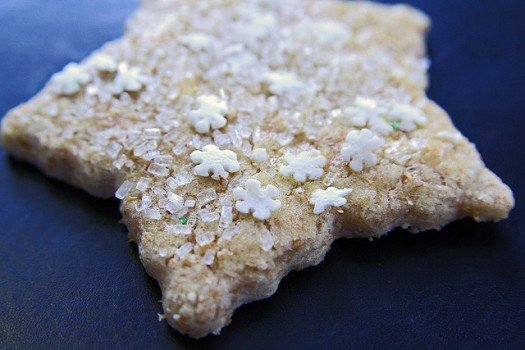5 Steps to Being a Lazy Gardener

Though the title of this post is a bit tongue in cheek, I really haven’t been a terribly conscientious or hardworking gardener so far this spring. Just feeling all-around busier this year than last, and having to contend with a 5, 6 and now 7 months pregnant belly, has quite simply cut down on time, energy and motivation to really get out there and get the hard work done.
And so here are my “tips”, from a truly “lazy” gardener, and how it’s been working out for me so far!
1) Keep Fertilizing and Soil Care Simple.
Unless you’re just starting out with really poor quality soil (as I was somewhat last year- it had lots of worms but definitely needed some TLC), you can get by with doing less if you have to. I simply didn’t have the energy this year to source out a whole bunch of compost or manure (and my compost last year had some issues, some of my own doing and some because someone tinkered with my bin, so I haven’t had a whole lot of usable compost).
Instead, after I hand-tilled each of my raised beds, I simply sprinkled in a good amount of a store-bought fertilizer that I found last year and mixed it in well before planting. The fertilizer I’m using is called Nutri-Rich and it is a 100% natural, organic fertilizer containing no synthetic ingredients. I bought it from Azure Standard food coop. It is a 4-3-3 fertilizer mix and also contains calcium.
As some crops get nearer to harvest and need a bit of a boost, I am just adding another sprinkle around the plants and then watering well to release the nutrients into the soil. I also picked up a bag of composted cow manure, just to change things up a bit, and I’ll add a bit of that to my plants as well. Though there is much more that I could be doing in terms of really feeding my soil, this is what I have energy for right now, and therefore this works for me!

2) Plant Wide and Thick.
This is a technique that I am just trying out for the first time this year. I got the idea from a book called Joy of Gardening. Basically, rather than doing square foot style planting or row planting, you sow blocks of soil (mine are about 2-3 ft by 2-3 ft, depending on the block) with a thick covering of seeds. This works with crops like turnips, radishes, beets, lettuce and other greens, carrots, peas, etc. Depending on the size of plant, you do it a bit more thickly or thinly as needed (carrots a bit more thickly than peas, for example).
Although this has it’s downsides, namely some uneven germination and spacing and the need to do some thinning, it also has several benefits. One is ease of planting. No digging holes or making lines to follow, no trying to separate individual seeds or carefully measuring out your plot. My method was to prepare the block of soil, grab the packet of seeds, try to distribute them evenly over the area, then cover with a bit of soil. So easy!
More recently, the second benefit I see is that even though I have done basically zero weeding, the blocks are so full of plants that there isn’t a whole lot of room for weeds to grow. This has been especially true with my turnips, peas and lettuce. Carrots take longer to get big and leafy tops, so that patch is certainly a bit weedier, as is my spinach patch where I had poor seed germination and therefore very few plants. Overall, though, this technique definitely has it’s perks!
3) Let Your Plants Get Their Own Water.
I think this is a lesson that you learn increasingly the longer you garden. It’s simply not necessary to get out there and water every two days or so. I think that I have only purposefully watered my entire garden 3 times in 2 months, and that was simply because I didn’t want my seeds to dry out while germinating (because then they would die), and once before going away on a weekend that I thought would be quite warm and not likely to rain at all.
When plants are left to fend for themselves without being fed by the sprinkler or hose, they learn to develop long and strong roots that are capable of reaching deep down into the soil to get the necessary moisture for growth. In the long run, this produces stronger plants overall. The major added benefit of doing this is that you don’t have to spend your time and energy watering, as well as needing to rely less on unfiltered city water (which contains chlorine and other such lovely chemicals), but rather on rain and groundwater (which in theory should be a bit cleaner of a source when you’re trying to grow organically).

4) Lighten Up About Looks.
My garden isn’t the prettiest it’s ever been. There are a lot of weeds around the edges, in the pathways (though my hubby cleaned those out a bit yesterday- thanks sweetie!) and yes, in with the veggies. Some spots look a bit random because of how the seeds happened to spread out and germinate, without careful planting.
I’ve decided to not care this year. I’ll do my best to keep up with it, and I do have more weeding and tending to the garden in my future plans (this afternoon, even). But, I have happily discovered that even with weeds as their neighbors, my plants are still growing and yes, producing! Here’s a clip from a gardening ebook I like (Mama’s Guide to Growing your Groceries) that encouraged me in this:
I feel a slight bit of shame as I write this today. As I sit here typing, it is no longer January; it’s October, and having dealt with a sprained ankle and high heat most of the summer, my garden looks like I am trying to create a meadow. That is a fancy way of saying I have weeds so huge my garden doesn’t look like a garden. Under the goldenrod, and milkweed, I find pumpkins, squash and tomatoes. My red peppers did very well this year. We actually got quite a high yield, despite what it looks like. Again, ideals are one thing; reality is quite another.
5) Pick, Eat and Be Merry!
If you have followed all of my steps above, within 1-2 months of planting you should be able to begin my recent late afternoon ritual: walk barefoot out to the garden, overlook the weeds, revel in all that it growing and gloriously green, then fill a bowl with choice baby greens and radishes, and mosey on back inside to make us a salad.
Next, we look forward to the peas that began to flower this past week. And the baby turnips just about ripe for the plucking. The carrots and onions that could start to be consumed in a couple of weeks time. The spinach and kale that are nearly pickable. The cauliflower and broccoli that should start to produce heads any time!
Really, truly, it’s easier than you might think. You, too, can be a lazy gardener and enjoy a bounty of fresh, organic veggies straight from your backyard! 🙂
Any other tips from my “lazy” gardening buddies out there? How do you keep the work in your garden minimal? What has worked for you in particularly busy or tiring seasons of life?
Other Related Posts You May Enjoy:
- A Tale of Two Gardens part one and part two
- How to Plan Your Garden part one and part two
- Organization in the Garden: Evaluating What You Have and What You Need
- Getting Organized in the Garden: Seed Starting and Planting Schedule
- Naturally Controlling Pests in the Organic Garden
- Gardening in Less-than-Ideal Spaces
- 7 Gardening Lessons from a Novice Gardener
- Selecting Seeds for Garden Success
- Gardening with Herbs 101: Where to Begin
- Gardening with Herbs 101: What To Grow
- How to Plant a Garden that Works for Where You Live
- 7 Reasons to Square Foot Garden
- Plan & Plant Now for Sustainability, Freedom, and a Backyard Revolution



We’re doing our first garden with our three preschoolers this year. We chose to use containers and it’s been pretty easy so far – we are considering it a grand experiment, and we’ll take what we learn and apply it to next year!
Jamie
Another lazy gardening technique…
Apparently we had some seeds in our compost. We’ve had a ton of ‘volunteers’ this year. I’ve been letting things sprout and have numerous squash plants and tomato plants coming up all on their own! It will be fun to find out what varieties they are when they start producing. 🙂
Hi~
I can relate to this post in many ways~ We used the Joy of Gardening book oh dear some 23 years ago and was blessed with the ease of a huge garden and also blessed with a bountiful harvest~
Many Blessings to you and yours~
Tamela
Stephanie, I’m impressed that you are gardening while pregnant! The grass certainly isn’t growing underneath your feet! I have found that with children I had to make some compromises in several areas in homemaking, but in doing so, it made me less uptight about little ones being a part of the process – no real worries about “what if they messed it up and it didn’t work”. As they got older, we could work on some of the finer points of homekeeping and gardening. By the way, I think your garden is looking very promising for a nice harvest, which is the main goal anyway, right?
My lazy gardener tip – I’m putting newspaper with seedless straw down on top of it around my boxes to encourage earthworms and discourage weeds. It should keep the path ways where I can navigate them easier. Eventually, it should all compost.
I can relate. Last year I was pregnant (throwing up between planting seeds in the spring and then a big belly to contend with in the fall). This year I have a 3 year old and a baby…its been interesting. The 3 year old wants to help (I let her with the big seeds, she is really good at beans) and the baby sometimes doesn’t want to just sit and watch when I want her to. 🙂 LOL. I use a second hand umbrella to shade her while she sits in a bouncy chair when she will sit. Last night we put her in our bike trailer stroller thingy with the bug net since the bugs were bad. I do a lot of planting when my husband is home, after supper… he can hold the baby and the preschooler is sleeping. Last night I was out there until 9 pm, thankfully it gets dark here just after 10 right now. I think I have it 75% done now. Its just been so cold and rainy (we had a bit of snow Sunday).
I like the quote “ideals are one thing, reality is another” so true…I have huge ideals but ended up buying the best compost I could get (although its not perfect) since I have awful soil (even with the large soil purchase we bought, we would otherwise have 100% clay).
The best lazy thing for me is to eliminate as much of the issues as I can. My adaptation of square foot gardening works well for me. I don’t use any borders like you do for your beds since the earwigs love to hide in wood. Also, get seeds that do well for your area. I spend a bit more on seeds, but I get varieties that do well in cooler, short seasons. That helps a lot with less frustration. Many seeds that I have state right on it “good in cool, wet soil, fast to grow, etc”
Thanks for the tips! As a first-time gardener, I really appreciate them!
Thanks for the advice. I love the block gardening idea. I think I will fill in some areas in my garden. I have been planting every couple of weeks spinach and lettuce greens, so there readiness is spaced out over the summer. I love to read your blog.
I think your garden looks great! I decided to be brave again and try another garden. So far so good…..I did have to do a bit of watering though because it’s been very hot with little rain around here (odd for where we live!).
Hi Renee!
I loved your lazy gardener tips!! The watering one is so very true — somehow the plants manage to find water once they get established.
This year we are trying a new-to-us lazy gardening technique: black plastic. We have a huge garden and in past years we got so sick of weeding that we had started to hate anything to do with the garden.
Here is a link to how we got our plastic covered garden going:
http://farmhomelife.blogspot.com/2009/05/garden-is-in.html
It’s been 12 days since we put our garden in and all the seeds have germinated and are vigoursly making their way up through the holes in the plastic. The plastic is helping to keep the soil quite moist. We are really hoping this works out because an almost weedless garden is something we’ve only dreamt about.
Take Care,
Trixie
I loved this post.
Last week, I was trying to work in the garden, putting in the last of our transplants, and our little 17 month old princess was following me and pulling up the plants as fast as I could plant them. I had to remind myself, some people are raising vegetables, I am raising a girl. Which is, after all, much more important.
I hope you don’t mind, I talked about you in my blog:
http://i-refuse-to-recede.blogspot.com/2009/06/no-excuse.html
Is that last year’s garden or this year’s? My growing season just started a few weeks ago, so I can hardly discern between the weeds and the food. I hope it becomes obvious soon or I’ll have to eat the weeds.
At 39 weeks pregnant I’ve wondered if doing a garden was such a good idea! However, the best way I’ve kept up is doing a little (sometimes very, very, little) each day. I try to spend 10-15 minutes in the garden while my daughter plays on her slide. So far so good. And once the baby arrives I’m recruiting some friends’ kids to come do things for me. 😉